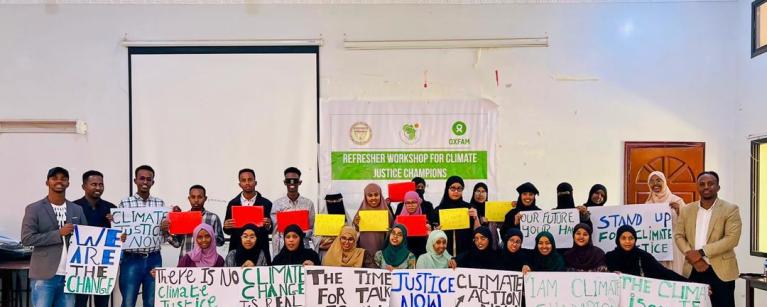Somalia faces a severe and multifaceted challenge from climate change, despite its minimal contribution to global greenhouse gas emissions. The nation experiences a destructive swing between extreme droughts and devastating floods, leading to destroyed livelihoods, deteriorated pastureland, and recurring humanitarian crises. Currently, the country is grappling with below-average rainfall and soaring temperatures, often exceeding 40 degrees Celsius in many regions. The impacts are felt differently across Somalia, with varying vulnerabilities depending on whether regions are riverine or more prone to drought, and the strength of local institutional support. Environmental degradation, including deforestation and coastal erosion, further compounds these climate-related stresses.
The Role of Academia and Community-Based Organizations (CBOs)
In this challenging context, CBOs and academic institutions in Somalia play a crucial and dynamic role. These actors are at the forefront of identifying and implementing locally led solutions to address climate change impacts. CBOs possess an intimate understanding of community needs and the local context, while academia brings valuable knowledge, research capabilities, and the capacity to provide training and education. Together, they actively raise awareness about climate change through workshops, seminars, and outreach programs, and empower communities by providing essential skills and resources. Their involvement extends to mobilising local populations, particularly youth, to become active participants in climate action, and they play a vital role in bridging indigenous knowledge with formal scientific expertise. Furthermore, CBOs and academia engage in advocacy and policy influencing, striving to ensure that local voices are heard in national climate policy discussions.
Collaboration on Locally Led Solutions
Recognising the complementary strengths of these two sectors, there has been a significant collaboration between various stakeholders to foster locally led solutions in Somalia and Somaliland. This partnership approach involves onboarding local partners to implement context-specific initiatives across different regions. Activities are designed based on the unique geographic locations and needs of communities, acknowledging that local actors possess the deepest understanding of their challenges. By combining the grassroots insights of CBOs with the research and training capacities of academic institutions, these collaborations aim to develop and implement climate change solutions that are not only effective and sustainable but also truly owned and driven by the communities they serve. This AACJ Community of Practice session dove deep into the examples of this collaboration of AACJ and a local environmental organisation, Green Hope Movement in Somalia and the University of Hargeisa in Somaliland.
Key Achievements
- Capacity Building: Over 1,088 individuals, with a significant 67% being women, were empowered through training and workshops focusing on climate action. This emphasis on gender-transformative interventions was a key priority.
- Youth Engagement: The launch of the climate justice incubator graduated over 120 students equipped to address climate justice issues. The Green Hope Movement ambassador program mobilised over 250 youth climate activists to lead climate action, aiming to reach 500 ambassadors by the end of 2025. Currently, they have 135 trained ambassadors. Additionally, 20 students from the University of Hargeisa received climate justice training and subsequently led initiatives in four districts.
- Awareness and Education: The launch of a children's book in Somali aimed at early climate education was a notable achievement. Green Hope Movement ambassadors are actively providing regular climate education and information to communities.
- Practical Climate Action: Initiatives such as tree planting (200 drought-resistant trees by universities), promotion of rainwater harvesting techniques (mini dams, sand dams), support for climate-smart agriculture, and mangrove rehabilitation were implemented.
- Community-Specific Solutions: Various CBOS undertook tailored actions, including campaigns on deforestation and addressing the impact of climate change on women's health.
- Policy Engagement: Local partners have engaged with government ministries and participated in national climate policy dialogues.
Challenges & Limitations
Limited funding was a significant factor that restricted the reach of local initiatives. This financial constraint directly impacted the ability of these initiatives to expand their outreach and engage a wider audience.
Lessons Learned
Local Actors are Effective in Raising Awareness and Implementing Adaptation
CBOs and students possess the ability to effectively raise awareness about critical climate issues through diverse methods like workshops, seminars, and digital platforms. Furthermore, they can successfully lead the practical implementation of climate adaptation activities such as tree planting and the use of drought-resistant seeds at a community level. This highlights their capacity to translate knowledge into tangible action on the ground.
Collaboration Enhances Policy Influence and Advocacy
The partnership between local actors and supporting organisations facilitates greater engagement in national climate policy processes. CBOs and academia can participate in dialogues related to policies like the Nationally Determined Contributions (NDCs), ensuring that local perspectives inform national strategies.
Capacity Building Needs to be Ongoing and Comprehensive
There is a continuous need to improve training models to include more technical aspects like loss and damage and climate finance. This ensures that local actors have the advanced knowledge required to address the complexities of climate change.
Shared by Abdinasir Abudullahi, Oxfam Somalia
Abdullahi Abdi Ali, Green Hope Movement
Mubarik Yusuf, University of Hargeisa
